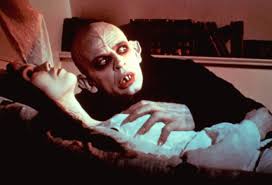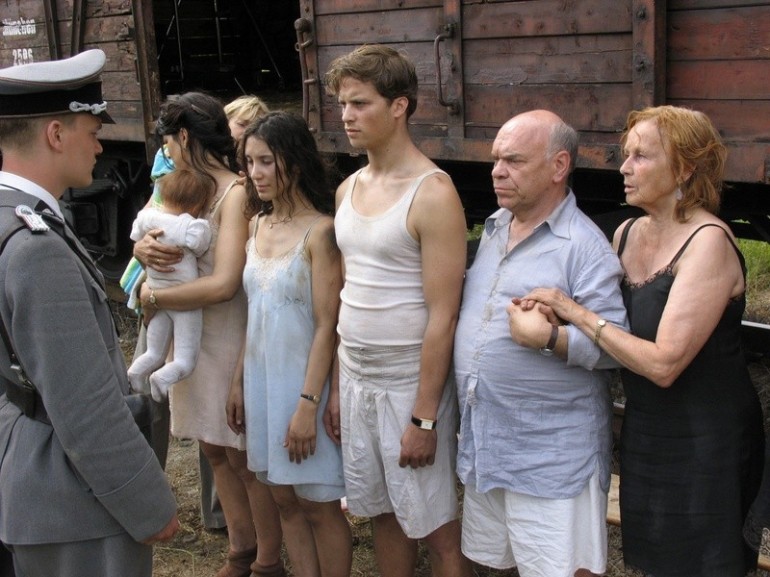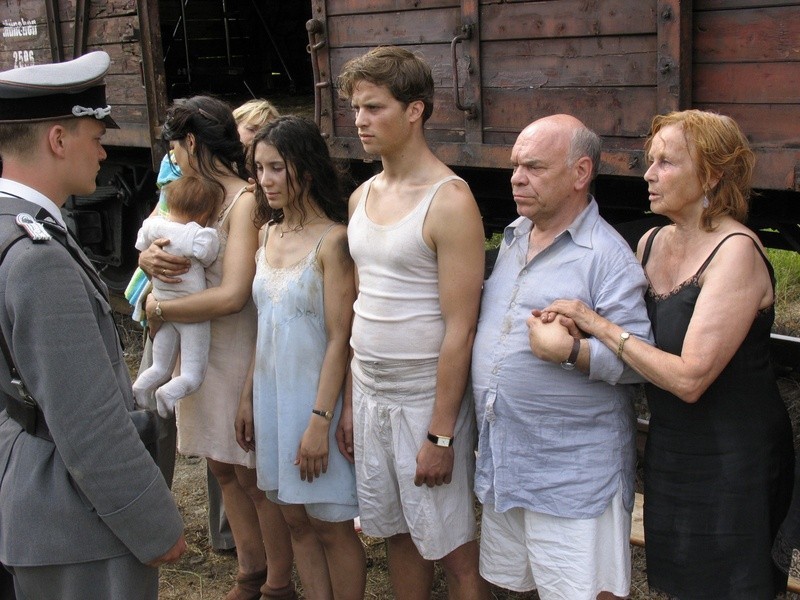
THE WANNSEE CONFERENCE. (1984) BASED ON TRUE EVENTS. WRITTEN BY PAUL MOMMERTZ. DIRECTED BY HEINZ SCHIRK. STARRING DIETRICH MATTAUSCH AND GERD BÖCKMANN.
REVIEW BY SANDRA HARRIS. ©
This is one of the best, if the absolute grimmest, of all the Nazi films I’ve ever seen. It’s as good as DOWNFALL (DER UNTERGANG), the gripping story of Hitler’s last days in the bunker under the Reich Chancellery in Berlin, while the Russian army were less than a few miles away and their bombs and explosions shook every building in Berlin to its foundations.
It’s so realistic, THE WANNSEE CONFERENCE, that every time I watch it I feel like I’m watching a piece of found footage, that this is what actually happened, that this is exactly what happened when some of the Nazis’ top personnel got together at this luxurious villa in Wannsee in Berlin to discuss the finer details of what came to be known as ‘The Final Solution’ to the so-called ‘Jewish Question.’
Only one copy of the ‘minutes’ of the meeting survived the war, and it is from this that the dialogue is derived. The dialogue is of necessity fictionalised, but it comes from an extremely true place, as it were.
The purpose of the meeting was threefold: to thrash out the details of the Final Solution; to ensure the co-operation of the various Nazi government departments, who were represented at the meeting, in the carrying out of the Final Solution; and, finally, to decide who or what constituted a Jew, and therefore should be included in the Final Solution.
The meeting, which had been delayed a bit by America’s entry into the war after Pearl Harbour happened in December 1941, took place at the beautiful private villa in Berlin at the behest of the Reichsfuhrer-SS, otherwise known as Heinrich Himmler, one of Hitler’s ‘bestest’ men.
It was Hitler’s wish that the German Reich and all her occupied territories should be made ‘Juden-frei’ or ‘free of Jews,’ and Hitler’s wish was ‘Heini’s’ command. Hitler rarely troubled himself with the finer details of any of his policies, unless it was for the grandiose pie-in-the-sky model cities and buildings he intended to create after the war, which of course never happened. There was no ‘after the war’ for Hitler.
But the worse things became for Germany in the war, the more he immersed himself in these blueprints for mad projects that would never get done. It was obviously his chosen form of escapism, something in which he could retreat when the going got tough.
The onerous tasks pertaining to the Final Solution were left to his top men, who in turn sub-delegated the job to underlings and so on and so on until the job was done. Hitler and Himmler both envisioned a kind of ‘combing’ movement that ‘swept’ Europe ‘clean’ of Jews from left to right and vice versa, the way you’d go through a child’s hair with a fine-tooth comb during an epidemic of what we used to call ‘unwelcome visitors.’
Himmler delegated the job of making Germany and her occupied territories ‘Juden-frei’ to his pet toady, Reinhard Heydrich, tall, blonde, perfectly ‘Aryan’-looking and so cold he’d make the icy winds that blew around the glacier that proved the Titanic’s downfall feel like a gentle Caribbean breeze. The actor who portrays him here is so like I imagine the real Heydrich to be that it’s actually scary. No, scratch that. It’s terrifying.
The Nazis invited to this conference sit around a long polished table in their highly decorated uniforms, gorging themselves on delicious finger food, fine cigars and fancy cognacs while they hammer out the details of the Final Solution. As the star-struck secretaries in the reception areas outside the conference rooms put it, ‘there’s a lot of top brass here today.’
Hitler gets ‘heiled’ more times than you can shake a stick at. Facts and figures are thrown around while the various personnel report to Heydrich how ‘Juden-frei’ the areas under their personal responsibility have become or are hoped/intended to become in the near future.
Maps of occupied Europe are displayed to the room, with little coffins on them indicating the places where large numbers of Jews have already been killed. It’s shocking to the viewer, these little coffins, but the attendees don’t even bat an eyelid. The coffins are only used to represent Jews, after all, and not real people.
No-one wants to be found wanting in the presence of ‘Heini’s’ little pet, Reinhard Heydrich, regarded by many historians as one of the main architects of the Holocaust. Hitler dubbed Heydrich ‘the man with the iron heart.’ In other words, he has a swinging brick where the command central of his emotions and feelings is meant to be.
It is openly admitted here amongst these men, maybe for the first time, that the Jews whom they intend to send to ‘labour camps in the East’ are in fact destined for the dreaded ‘special treatment’ or ‘sonderbehandlung’ in the occupied areas of Poland known as ‘the General Government.’
No words stronger than this ‘sonderbehandlung’ will ever be put down on paper for fear that they might incriminate themselves, but here, amongst themselves, it is safe to admit such things out loud, even in the presence of the female secretary who’s taking the minutes and the waiters who serve them with their cognacs and canapés. Those cocky gits. The top brass, I mean, not the waiters.
The process of getting the Jews to the ‘labour camps in the East’ is discussed step-by-step with cold practicality. ‘Israel’ and ‘Sarah,’ their derogatory names for the male and female Jew, will obediently sign over their property to the Reich and hand the keys of their dwelling(s) over to the designated Nazi officials.
Then, carrying one suitcase and the paltry sum of no more than fifty marks- which will all be stolen from them at their destination anyway- they will board a train (most likely a cattle train) to ‘the East’ in a quiet and orderly fashion.
The destination will be one or other of the various concentration camps (Auschwitz, Treblinka, Sobibor, Mauthausen, Dachau, Bergen-Belsen, Belzec) and, at the end of the road, they’ll find the gas chambers and crematoria waiting silently for them.
Gas? Some of the men around the table, one in particular, pale a little at the mention of the gas. Either they didn’t know about it prior to today, or it just slightly offends their delicate, fastidious sensibilities to be hearing such nitty-gritty details.
Some people, the so-called ‘mental defectives’ and the disabled mostly, have already been put to death by means of travelling vans into which they would be piled and then killed by exhaust pipe, in much the same way that a person would commit suicide by sitting in their car with the exhaust running.
People grew to know in time that these vans heralded death for some. This is one way of doing it. But the downside of this method is that you can only kill a handful of people at a time. It’s slow and cumbersome, too slow and cumbersome.
Rudolf Höss, the commandant of Auschwitz whose post-war memoirs provide us with one of our most valuable documents of World War Two, gets a mention here then. He apparently ‘swears by Zyklon B,’ the pellets of insecticide that have been proven capable of murdering large numbers of people at a time.
The Jews are ushered into an ‘undressing room,’ where they are told to remember where they put their stuff for afterwards. This lulls them into a false sense of security, making them think that there will be an ‘afterwards.’
Once they are locked securely into the gas chambers, an SS man- it was always an SS man- will nip up sharpish onto the roof of the building and drop the pellets of Zyklon B in through an opening.
It could take several minutes for the gas to take full effect and the hundreds- or thousands- of people inside the room to die. There could be shouting and screaming for several minutes after the doors are locked. Victims could be observed through a peephole in the door.
Then the Sonderkommando, the concentration camp prisoners tasked with doing this horrible, horrible job that the SS themselves didn’t want, enter the room with gas-masks on to cart the bodies off to the nearby crematorium for burning.
The sights that would await them when those doors were opened were truly terrible. With blood, faeces and urine dripping from every orifice and their heads sometimes twisted on backwards with the pain and fear of what they’d undergone, the corpses were shocking to behold. Some members of the Sonderkommando might have to take pliers and remove the gold teeth from the mouths of corpses, surely the job straight from the jaws of hell itself.
Every so often, the members of the Sonderkommando would be themselves murdered and replaced by other prisoners. They were never left alive for long. The SS didn’t want people who knew so many of their grisly secrets to be walking around free, free to tell everyone they met about what they’d witnessed and experienced in the death camps.
At the conference, a lot of time is spent debating the ‘half-Jews’ and ‘quarter-Jews,’ and how exactly you determine whether someone is one or the other and how you then treat them. Previously, Jews married to Aryans or who had been married to Aryans but were now widowed had been exempt from ‘Sonderbehandlung,’ but now there’s talk of a clean sweep, of cutting all the ‘bacteria’ out of the diseased organism for good, for the good of the organism. This analogy from the plant world comes courtesy of one Adolf Hitler, by the way. Have you read MEIN KAMPF yet? Great cure for insomnia.
It’s a bit like a privileged gentleman’s club, this conference. Whenever any Nazi official proposes something particularly bloodthirsty for the Jews, most of the others rattle and bang the table with their fists and make approving, ‘hear, hear’- type noises, while swilling their pricey cognacs and smoking their fat cigars.
‘Why should our chaps die at the front while Israel and Sarah swan off to a holiday resort?’ one official says of the concentration camps. Well, Israel and Sarah will soon know the real meaning of work, the Nazis say, as the plan for any able-bodied Jews is forced labour and for them to be worked literally to death.
Another man is worried about whether he will lose his Jews- his free labour, he means- to the camps, as he needs them for his armaments factories. Why import and pay foreign workers, he says, when you can get the Jews for nothing? He’s delighted to hear that he can hold onto his slaves, at least for now.
The main player here, even more than Heydrich himself, who shamelessly chats up the pretty secretary (What’s WRONG with her, by the way? Has she no womanly feelings of compassion for the victims of genocide under discussion, or is she only interested in landing herself a man, preferably a high-ranking Nazi officer?) in front of everyone present and who expects a ripple of sycophantic laughter every time he cracks a little joke, is probably Adolf Eichmann. He’s the ‘numbers’ man and Heydrich’s so-called ‘Jew specialist’ or ‘Jew expert.’
He’s the un-extraordinary ‘petty bureacrat’ or pen-pusher about whom German-Jewish philosopher Hannah Arendt made her remarks referring to ‘the banality of evil.’ This was while Eichmann was on trial for war crimes in Israel in 1961, after being snatched from Buenos Aires by the Israeli group Mossad. He’d been hiding in South America since the war, having escaped from Europe via the ‘ratlines’ used by escaping Nazis for that exact purpose.
‘I was only a tiny cog in the Nazi killing machine,’ was his catch-cry during his trial, after which he was hanged for his crimes. This was how he liked to minimise his actions but we know that he attended this milestone conference. We know that he was one of the main Nazis responsible for organising the Jews onto those cattle trains that would take them to those mythical ‘labour camps in the East.’
A monster doesn’t always have to look like a monster, and be actually caught in the act of grinding children’s bones to make his bread, to have been responsible for the atrocities with which he’s charged. Eichmann is certainly a case in point for this particular argument.
He’s the Nazi who infamously said that when he died, he’d jump into the pit of hell with glee, happy in the knowledge that he had put six million Jews down there with him. Here, he’s certainly a fussy little bureaucrat, kissing Heydrich’s butt and pulling figures out of his sleeves and demonstrating his intimate knowledge of ‘The Jewish Question.’
I just want to bring one more conference attendee to your attention. There’s a portly, jowly official called Dr. (he has a degree in law) Rudolf Lange present, a young enough Nazi who was largely responsible for Latvia’s Holocaust. He’s another one who likes to get a laugh for his actions.
He falls asleep at one point, probably rendered dozey by all the cognac he downs at the meeting, and glories in the laugh this generates amongst his colleagues. To fall asleep while the details of the deaths of millions of people are being worked out seems irreverent, to say the least.
He’s brought his beloved German shepherd dog Hasso along to the conference with him because Hasso ‘needs a vacation.’ The inference here is that the dog is treated better than the Jews under discussion at the conference. He’s a great dog also, apparently, for ‘sniffing out Jews’ from their hiding places ‘in the latrines’ or ‘up chimneys.’ The film ends with Lange throwing a ball or a stick for the dog.
The whole film is an exercise in ‘show, not tell.’ The meeting unfolds in real time and a certain amount of knowledge on the part of the viewer is assumed. No character sits down and says to his colleagues: ‘Now, folks, as we all know, this is World War Two and Germany is about to start losing the war in a big way,’ and so on.
The discussion is all highly practical, to the point and cold and calculating, and Heydrich advises the report-givers to ‘be brief’ as his time is valuable and his cool blonde Aryan presence is required elsewhere.
The pragmatic and bureaucratic way in which the subject is gone over is frightening. If Eichmann typified for Hannah Arendt ‘the banality of evil,’ then surely this conference taken as a whole is an example of the pettifogging, bureaucratic mind-numbing and also terrifying minutiae of evil. Could this type of thing ever happen again? Well, all it takes is for good men to do nothing…
AUTHOR BIOGRAPHY OF SANDRA HARRIS.
Sandra Harris is a Dublin-based novelist, poet, short story writer and film and book blogger. She has studied Creative Writing and Film-Making. She has published a number of e-books on the following topics: horror film reviews, multi-genre film reviews, womens’ fiction, erotic fiction, erotic horror fiction and erotic poetry. Several new books are currently in the pipeline. You can browse or buy any of Sandra’s books by following the link below straight to her Amazon Author Page:
http://www.amazon.com/-/e/B015GDE5RO
You can contact Sandra at:
https://www.facebook.com/SandraHarrisPureFilthPoetry
https://sandrafirstruleoffilmclubharris.wordpress.com
http://sexysandieblog.wordpress.com
http://serenaharker.wordpress.com
sandrasandraharris@gmail.com
https://twitter.com/SandraAuthor
















